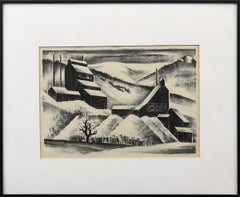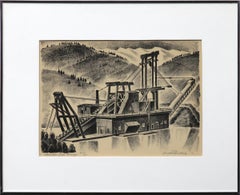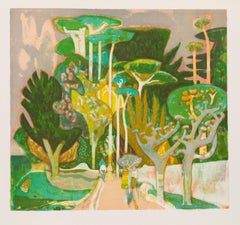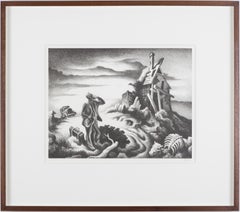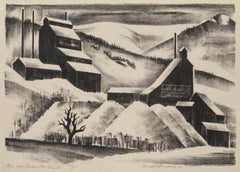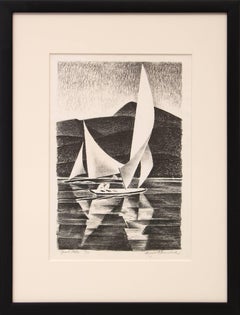Arnold Ronnebeck Landscape Prints
1885-1947
Modernist sculptor, lithographer and museum administrator, Rönnebeck was a noted member of European and American avant-garde circles in the early twentieth century before settling in Denver, Colorado, in 1926.
After studying architecture at the Royal Art School in Berlin for two years beginning in 1905, he moved to Paris in 1908 to study sculpture with Aristide Maillol and Émile-Antoine Bourdelle. While there he met and befriended American modernist painter, Marsden Hartley, of whom he sculpted a bronze head that was exhibited at the Salon d’Automne in Paris in 1912 and the following year at Hartley’s solo show of paintings at Alfred Stieglitz’s Gallery 291 in New York.
After World War I Rönnebeck traveled in Italy with German writer, Max Sidow, and German poet, Theodor Daubler, doing a series of drawings of Positano and the Amalfi Coast that formed the basis for his lithographs on the subject. The death of his finacée, the young American opera singer Alice Miriam in 1922 and his own family’s increasing financial problems in post-World War I Germany led him to immigrate to the United States in 1923. After living briefly with Miriam’s family in Washington, DC, he moved to New York where he became part of the avant-garde circle around Alfred Stieglitz.
In the summer of 1925, as the guest of Mabel Dodge Luhan, Rönnebeck first saw Taos, New Mexico, which Marsden Hartley had encouraged him to visit. It was there that he met his future wife, Louise Emerson, an easel painter and muralist. A year later they were married in New York before relocating to Denver. He served as director of the Denver Art Museum from 1926 to 1930 where he invited Marsden Hartley to lecture on Cézanne’s art in 1928. Rönnebeck fostered the development of the museum’s collection of American Indian art and the curation of modernist art exhibitions. In addition to his work at the museum, he was professor of sculpture at the University of Denver’s College of Fine and Applied Arts from 1929 to 1935, and wrote a weekly art column in the Rocky Mountain News.
In Colorado, the subject matter of his lithographs became the state’s landscape and its mining towns, as well as Native Americans from the pueblos in neighboring New Mexico. By the early 1930s Colorado’s old mining towns became a popular genre for artists because they were easily accessible, and their architectural components provided a welcome break from the nineteenth-century panoramic landscape tradition and the overwrought cowboy-and-Indian subject matter of the previous generation. As an amateur actor and music enthusiast, Rönnebeck had an additional connection with Central City.
In June 1947, some five months before his death, the Denver Art Museum organized a solo exhibition of his sculptures, watercolors and prints.
© copyright Stan Cuba for David Cook Galleries(Biography provided by David Cook Galleries)
to
1
5
4
4
3
2
1
3
1
Overall Height
to
Overall Width
to
5
4
2
2
1
1
1
1
1
1
1
5
5
10
138
132
128
113
5
4
Artist: Arnold Ronnebeck
Mine Near Continental Divide, Black White Colorado Mountain Landscape Winter
By Arnold Rönnebeck
Located in Denver, CO
Lithograph on paper titled 'Mine Near Continental Divide' by Arnold Ronnebeck (1885-1947) from 1933. Depicts a black and white winter scene of a mine in the mountains with snow on the rooftops and hillsides. Presented in a custom frame measuring 18 ¼ x 22 ¼ inches. Image size measures 10 ¼ x 14 ½ inches.
Provenance: Estate of the Artist, Arnold Ronnebeck
Expedited and international shipping is available - please contact us for a quote.
About the Artist:
Modernist sculptor, lithographer and museum administrator, Rönnebeck was a noted member of European and American avant-garde circles in the early twentieth century before settling in Denver, Colorado, in 1926.
After studying architecture at the Royal Art School in Berlin for two years beginning in 1905, he moved to Paris in 1908 to study sculpture with Aristide Maillol and Émile-Antoine Bourdelle. While there he met and befriended American modernist painter, Marsden Hartley, of whom he sculpted a bronze head that was exhibited at the Salon d’Automne in Paris in 1912 and the following year at Hartley’s solo show of paintings at Alfred Stieglitz’s Gallery 291 in New York. A frequent guest of Gertrude Stein’s Saturday "evenings" in Paris, she described Rönnebeck as "charming and always invited to dinner," along with Pablo Picasso, Mabel Dodge (Luhan) and Charles Demuth.
After the outbreak of World War I in 1914, Rönnebeck returned to Germany where he served as an officer in the German Imperial Army on the front lines. Twice wounded, including in the Battle of Marne in France, Kaiser Wilhelm II awarded him the Iron Cross. During the war Hartley fell in love with Rönnebeck’s cousin, Lieutenant Karl von Freyburg, who was killed in combat. As a tribute to Freyburg, Hartley created Portrait of a German Officer (1914) now in the Metropolitan Museum of Art in New York.
After the war Rönnebeck traveled in Italy with German writer, Max Sidow, and German poet, Theodor Daubler, doing a series of drawings of Positano and the Amalfi Coast that formed the basis for his lithographs on the subject. The death of his finacée, the young American opera singer Alice Miriam in 1922 and his own family’s increasing financial problems in post-World War I Germany led him to immigrate to the United States in 1923. After living briefly with Miriam’s family in Washington, DC, he moved to New York where he became part of the avant-garde circle around Alfred Stieglitz. His essay, "Through the Eyes of a European Sculptor," appeared in the catalog for the Anderson Gallery exhibition, "Alfred Stieglitz Presents Seven Americans: 159 Paintings, Photographs & Things, Recent & Never Publicly Shown, by Arthur G. Dove, Marsden Hartley, John Marin, Charles Demuth, Paul Strand, Georgia O’Keeffe, Alfred Stieglitz."
In New York Rönnebeck began producing Precisionist-style lithographs of the city’s urban landscapes which he termed "living cubism." Some of them were reproduced in Vanity Fair magazine. Through Stieglitz he met Erhard Weyhe head of the Weyhe Gallery who, with its director Carl Zigrosser, arranged Rönnebeck’s first solo American exhibition in May 1925 at the gallery in New York. Comprising some sixty works – prints, drawings and sculpture – the show subsequently traveled on a thirteen-month tour of major American cities. Until the end of his life, the gallery represented him, along with other American artists Adolf Dehn, Wanda Gag, Rockwell Kent, J.J. Lankes, Louis Lozowick, Reginald Marsh and John Sloan.
In the summer of 1925, as the guest of Mabel Dodge Luhan, Rönnebeck first saw Taos, New Mexico, which Marsden Hartley had encouraged him to visit. It was there that he met his future wife, Louise Emerson, an easel painter and muralist. A year later they were married in New York before relocating to Denver. He served as director of the Denver Art Museum from 1926 to 1930 where he invited Marsden Hartley to lecture on Cézanne’s art in 1928. Rönnebeck fostered the development of the museum’s collection of American Indian art and the curation of modernist art exhibitions. In addition to his work at the museum, he was professor of sculpture at the University of Denver’s College of Fine and Applied Arts from 1929 to 1935, and wrote a weekly art column in the Rocky Mountain News.
His best known Denver sculptures from the late 1920s in bronze, copper, stone, wood and terra cotta include a reredos, The Epiphany, at St. Martin’s Chapel; The History of Money (six panels) at the Denver National Bank; The Ascension at the Church of Ascension; and the William V. Hodges Family Memorial at Fairmount Cemetery. At the same time he did a series of terra cotta relief panels for La Fonda Hotel in Santa Fe, New Mexico. In the 1930s his bas-relief aluminum friezes of stylized Pueblo and Hopi Indian Kachina masks...
Category
1930s American Modern Arnold Ronnebeck Landscape Prints
Materials
Lithograph, Paper
Colorado Gold Dredge, Breckenridge, Signed Black and White Mining Lithograph
By Arnold Rönnebeck
Located in Denver, CO
Lithograph on paper titled 'Colorado Gold Dredge, Breckenridge' by Arnold Ronnebeck (1885-1947) from 1932. Numbered 15/25. Depicted is a gold dredge in Colorado mining town Breckenridge with a mountain landscape in the background. Presented in a custom frame measuring 17 ¼ x 21 ¼ inches. Image size measures 10 ¼ x 14 ¼ inches.
Print is clean and in very good vintage condition - please contact us for a detailed condition report.
Provenance: Estate of Arnold Ronnebeck
Expedited and international shipping is available - please contact us for a quote.
About the Artist:
Modernist sculptor, lithographer and museum administrator, Rönnebeck was a noted member of European and American avant-garde circles in the early twentieth century before settling in Denver, Colorado, in 1926.
After studying architecture at the Royal Art School in Berlin for two years beginning in 1905, he moved to Paris in 1908 to study sculpture with Aristide Maillol and Émile-Antoine Bourdelle. While there he met and befriended American modernist painter, Marsden Hartley, of whom he sculpted a bronze head that was exhibited at the Salon d’Automne in Paris in 1912 and the following year at Hartley’s solo show of paintings at Alfred Stieglitz’s Gallery 291 in New York. A frequent guest of Gertrude Stein’s Saturday "evenings" in Paris, she described Rönnebeck as "charming and always invited to dinner," along with Pablo Picasso, Mabel Dodge (Luhan) and Charles Demuth.
After the outbreak of World War I in 1914, Rönnebeck returned to Germany where he served as an officer in the German Imperial Army on the front lines. Twice wounded, including in the Battle of Marne in France, Kaiser Wilhelm II awarded him the Iron Cross. During the war Hartley fell in love with Rönnebeck’s cousin, Lieutenant Karl von Freyburg, who was killed in combat. As a tribute to Freyburg, Hartley created Portrait of a German Officer (1914) now in the Metropolitan Museum of Art in New York.
After the war Rönnebeck traveled in Italy with German writer, Max Sidow, and German poet, Theodor Daubler, doing a series of drawings of Positano and the Amalfi Coast that formed the basis for his lithographs on the subject. The death of his finacée, the young American opera singer Alice Miriam in 1922 and his own family’s increasing financial problems in post-World War I Germany led him to immigrate to the United States in 1923. After living briefly with Miriam’s family in Washington, DC, he moved to New York where he became part of the avant-garde circle around Alfred Stieglitz. His essay, "Through the Eyes of a European Sculptor," appeared in the catalog for the Anderson Gallery exhibition, "Alfred Stieglitz Presents Seven Americans: 159 Paintings, Photographs & Things, Recent & Never Publicly Shown, by Arthur G. Dove, Marsden Hartley, John Marin, Charles Demuth, Paul Strand, Georgia O’Keeffe, Alfred Stieglitz."
In New York Rönnebeck began producing Precisionist-style lithographs of the city’s urban landscapes which he termed "living cubism." Some of them were reproduced in Vanity Fair magazine. Through Stieglitz he met Erhard Weyhe head of the Weyhe Gallery who, with its director Carl Zigrosser, arranged Rönnebeck’s first solo American exhibition in May 1925 at the gallery in New York. Comprising some sixty works – prints, drawings and sculpture – the show subsequently traveled on a thirteen-month tour of major American cities. Until the end of his life, the gallery represented him, along with other American artists Adolf Dehn, Wanda Gag, Rockwell Kent, J.J. Lankes, Louis Lozowick, Reginald Marsh and John Sloan.
In the summer of 1925, as the guest of Mabel Dodge Luhan, Rönnebeck first saw Taos, New Mexico, which Marsden Hartley had encouraged him to visit. It was there that he met his future wife, Louise Emerson, an easel painter and muralist. A year later they were married in New York before relocating to Denver. He served as director of the Denver Art Museum from 1926 to 1930 where he invited Marsden Hartley to lecture on Cézanne’s art in 1928. Rönnebeck fostered the development of the museum’s collection of American Indian art and the curation of modernist art exhibitions. In addition to his work at the museum, he was professor of sculpture at the University of Denver’s College of Fine and Applied Arts from 1929 to 1935, and wrote a weekly art column in the Rocky Mountain News.
His best known Denver sculptures from the late 1920s in bronze, copper, stone, wood and terra cotta include a reredos, The Epiphany, at St. Martin’s Chapel; The History of Money (six panels) at the Denver National Bank; The Ascension at the Church of Ascension; and the William V. Hodges Family Memorial at Fairmount Cemetery. At the same time he did a series of terra cotta relief panels for La Fonda Hotel in Santa Fe, New Mexico. In the 1930s his bas-relief aluminum friezes of stylized Pueblo and Hopi Indian Kachina masks...
Category
1930s American Modern Arnold Ronnebeck Landscape Prints
Materials
Lithograph, Paper
Silver Mine, Russell Gulch (12/25) Abstract Black and White Print in Mountains
By Arnold Rönnebeck
Located in Denver, CO
Lithograph on paper titled 'Silver Mine, Russell Gulch (12/25)' by Arnold Ronnebeck, which is a black and white lithograph print of an oil painting by him of the same name. It shows a mine with a mountain ridge in the background. Presented in a custom frame measuring 20 ½ x 26 ½ inches. Image size measures 10 ¼ x 14 ¼ inches.
Print is clean and in very good vintage condition - please contact us for a detailed condition report.
Provenance: Estate of Arnold Ronnebeck
Expedited and international shipping is available - please contact us for a quote.
About the Artist:
Modernist sculptor, lithographer and museum administrator, Rönnebeck was a noted member of European and American avant-garde circles in the early twentieth century before settling in Denver, Colorado, in 1926.
After studying architecture at the Royal Art School in Berlin for two years beginning in 1905, he moved to Paris in 1908 to study sculpture with Aristide Maillol and Émile-Antoine Bourdelle. While there he met and befriended American modernist painter, Marsden Hartley, of whom he sculpted a bronze head that was exhibited at the Salon d’Automne in Paris in 1912 and the following year at Hartley’s solo show of paintings at Alfred Stieglitz’s Gallery 291 in New York. A frequent guest of Gertrude Stein’s Saturday "evenings" in Paris, she described Rönnebeck as "charming and always invited to dinner," along with Pablo Picasso, Mabel Dodge (Luhan) and Charles Demuth.
After the outbreak of World War I in 1914, Rönnebeck returned to Germany where he served as an officer in the German Imperial Army on the front lines. Twice wounded, including in the Battle of Marne in France, Kaiser Wilhelm II awarded him the Iron Cross. During the war Hartley fell in love with Rönnebeck’s cousin, Lieutenant Karl von Freyburg, who was killed in combat. As a tribute to Freyburg, Hartley created Portrait of a German Officer (1914) now in the Metropolitan Museum of Art in New York.
After the war Rönnebeck traveled in Italy with German writer, Max Sidow, and German poet, Theodor Daubler, doing a series of drawings of Positano and the Amalfi Coast that formed the basis for his lithographs on the subject. The death of his finacée, the young American opera singer Alice Miriam in 1922 and his own family’s increasing financial problems in post-World War I Germany led him to immigrate to the United States in 1923. After living briefly with Miriam’s family in Washington, DC, he moved to New York where he became part of the avant-garde circle around Alfred Stieglitz. His essay, "Through the Eyes of a European Sculptor," appeared in the catalog for the Anderson Gallery exhibition, "Alfred Stieglitz Presents Seven Americans: 159 Paintings, Photographs & Things, Recent & Never Publicly Shown, by Arthur G. Dove, Marsden Hartley, John Marin, Charles Demuth, Paul Strand, Georgia O’Keeffe, Alfred Stieglitz."
In New York Rönnebeck began producing Precisionist-style lithographs of the city’s urban landscapes which he termed "living cubism." Some of them were reproduced in Vanity Fair magazine. Through Stieglitz he met Erhard Weyhe head of the Weyhe Gallery who, with its director Carl Zigrosser, arranged Rönnebeck’s first solo American exhibition in May 1925 at the gallery in New York. Comprising some sixty works – prints, drawings and sculpture – the show subsequently traveled on a thirteen-month tour of major American cities. Until the end of his life, the gallery represented him, along with other American artists Adolf Dehn, Wanda Gag, Rockwell Kent, J.J. Lankes, Louis Lozowick, Reginald Marsh and John Sloan.
In the summer of 1925, as the guest of Mabel Dodge Luhan, Rönnebeck first saw Taos, New Mexico, which Marsden Hartley had encouraged him to visit. It was there that he met his future wife, Louise Emerson, an easel painter and muralist. A year later they were married in New York before relocating to Denver. He served as director of the Denver Art Museum from 1926 to 1930 where he invited Marsden Hartley to lecture on Cézanne’s art in 1928. Rönnebeck fostered the development of the museum’s collection of American Indian art and the curation of modernist art exhibitions. In addition to his work at the museum, he was professor of sculpture at the University of Denver’s College of Fine and Applied Arts from 1929 to 1935, and wrote a weekly art column in the Rocky Mountain News.
His best known Denver sculptures from the late 1920s in bronze, copper, stone, wood and terra cotta include a reredos, The Epiphany, at St. Martin’s Chapel; The History of Money (six panels) at the Denver National Bank; The Ascension at the Church of Ascension; and the William V. Hodges Family Memorial at Fairmount Cemetery. At the same time he did a series of terra cotta relief panels for La Fonda Hotel in Santa Fe, New Mexico. In the 1930s his bas-relief aluminum friezes of stylized Pueblo and Hopi Indian Kachina masks...
Category
1930s American Modern Arnold Ronnebeck Landscape Prints
Materials
Paper, Lithograph
House at Gregory Point (Colorado), 1930s Black and White Landscape Lithograph
By Arnold Rönnebeck
Located in Denver, CO
Original Arnold Ronnebeck (1885-1947) lithograph of a home in Gregory Point, near Central City, Colorado from the 1930s. Edition of 25 printed. Presented in a custom frame, outer dimensions measure 23 ¼ x 18 ½ inches. Image size is 19 ¼ x 13 ¼ inches
Print is clean and in very good vintage condition - please contact us for a detailed condition report.
Provenance: Estate of Arnold Ronnebeck
Expedited and international shipping is available - please contact us for a quote.
About the Artist:
Modernist sculptor, lithographer and museum administrator, Rönnebeck was a noted member of European and American avant-garde circles in the early twentieth century before settling in Denver, Colorado, in 1926.
After studying architecture at the Royal Art School in Berlin for two years beginning in 1905, he moved to Paris in 1908 to study sculpture with Aristide Maillol and Émile-Antoine Bourdelle. While there he met and befriended American modernist painter, Marsden Hartley, of whom he sculpted a bronze head that was exhibited at the Salon d’Automne in Paris in 1912 and the following year at Hartley’s solo show of paintings at Alfred Stieglitz’s Gallery 291 in New York. A frequent guest of Gertrude Stein’s Saturday "evenings" in Paris, she described Rönnebeck as "charming and always invited to dinner," along with Pablo Picasso, Mabel Dodge (Luhan) and Charles Demuth.
After the outbreak of World War I in 1914, Rönnebeck returned to Germany where he served as an officer in the German Imperial Army on the front lines. Twice wounded, including in the Battle of Marne in France, Kaiser Wilhelm II awarded him the Iron Cross. During the war Hartley fell in love with Rönnebeck’s cousin, Lieutenant Karl von Freyburg, who was killed in combat. As a tribute to Freyburg, Hartley created Portrait of a German Officer (1914) now in the Metropolitan Museum of Art in New York.
After the war Rönnebeck traveled in Italy with German writer, Max Sidow, and German poet, Theodor Daubler, doing a series of drawings of Positano and the Amalfi Coast that formed the basis for his lithographs on the subject. The death of his finacée, the young American opera singer Alice Miriam in 1922 and his own family’s increasing financial problems in post-World War I Germany led him to immigrate to the United States in 1923. After living briefly with Miriam’s family in Washington, DC, he moved to New York where he became part of the avant-garde circle around Alfred Stieglitz. His essay, "Through the Eyes of a European Sculptor," appeared in the catalog for the Anderson Gallery exhibition, "Alfred Stieglitz Presents Seven Americans: 159 Paintings, Photographs & Things, Recent & Never Publicly Shown, by Arthur G. Dove, Marsden Hartley, John Marin, Charles Demuth, Paul Strand, Georgia O’Keeffe, Alfred Stieglitz."
In New York Rönnebeck began producing Precisionist-style lithographs of the city’s urban landscapes which he termed "living cubism." Some of them were reproduced in Vanity Fair magazine. Through Stieglitz he met Erhard Weyhe head of the Weyhe Gallery who, with its director Carl Zigrosser, arranged Rönnebeck’s first solo American exhibition in May 1925 at the gallery in New York. Comprising some sixty works – prints, drawings and sculpture – the show subsequently traveled on a thirteen-month tour of major American cities. Until the end of his life, the gallery represented him, along with other American artists Adolf Dehn, Wanda Gag, Rockwell Kent, J.J. Lankes, Louis Lozowick, Reginald Marsh and John Sloan.
In the summer of 1925, as the guest of Mabel Dodge Luhan, Rönnebeck first saw Taos, New Mexico, which Marsden Hartley had encouraged him to visit. It was there that he met his future wife, Louise Emerson, an easel painter and muralist. A year later they were married in New York before relocating to Denver. He served as director of the Denver Art Museum from 1926 to 1930 where he invited Marsden Hartley to lecture on Cézanne’s art in 1928. Rönnebeck fostered the development of the museum’s collection of American Indian art and the curation of modernist art exhibitions. In addition to his work at the museum, he was professor of sculpture at the University of Denver’s College of Fine and Applied Arts from 1929 to 1935, and wrote a weekly art column in the Rocky Mountain News.
His best known Denver sculptures from the late 1920s in bronze, copper, stone, wood and terra cotta include a reredos, The Epiphany, at St. Martin’s Chapel; The History of Money (six panels) at the Denver National Bank; The Ascension at the Church of Ascension; and the William V. Hodges Family Memorial at Fairmount Cemetery. At the same time he did a series of terra cotta relief panels for La Fonda Hotel in Santa Fe, New Mexico. In the 1930s his bas-relief aluminum friezes of stylized Pueblo and Hopi Indian Kachina masks...
Category
1930s American Modern Arnold Ronnebeck Landscape Prints
Materials
Paper, Lithograph
Grand Lake, Yacht Races, Colorado Mountain Lake, 1930s Black White Print
By Arnold Rönnebeck
Located in Denver, CO
Grand Lake, Colorado, Yacht Races, vintage 1930s modernist, WPA era black and white lithograph by Colorado artist, Arnold Ronnebeck (1885-1947). Lake with ...
Category
1930s American Modern Arnold Ronnebeck Landscape Prints
Materials
Lithograph
Related Items
Old Village, Modern Lithograph by Millard Sheets
By Millard Sheets
Located in Long Island City, NY
Old Village by Millard Owen Sheets, American (1907–1989)
Circa 1977
Lithograph on Arches, signed and numbered in pencil
Edition of 250, AP
Image Si...
Category
1970s American Modern Arnold Ronnebeck Landscape Prints
Materials
Lithograph
Prodigal Son
By Thomas Hart Benton
Located in London, GB
A fine impression with full margins published by Associated American Artists with their information label present - pictured in Art and Popular Religion in Evangelical America, 1815-...
Category
1930s American Modern Arnold Ronnebeck Landscape Prints
Materials
Lithograph
Original "Back Our Girls Over There, YWCA vintage WW1 poster
By Clarence Underwood
Located in Spokane, WA
Original Back Our Girls Over There Y.W.C.A. WW1 antique poster: Linen-backed original Beautiful Y.W.C.A. Telephone operator sitting at the control pane...
Category
1910s American Modern Arnold Ronnebeck Landscape Prints
Materials
Lithograph
H 28 in W 21.5 in D 0.05 in
Down the River
By Thomas Hart Benton
Located in London, GB
A fine impression of this popular Benton image with good margins.
Category
1930s American Modern Arnold Ronnebeck Landscape Prints
Materials
Lithograph
Original "Ring It Again, Third Liberty Loan vintage WW1 poster
Located in Spokane, WA
Original poster: Ring it Again Third Liberty Loan. Buy U. S. Gov't Bonds. World War 1 lithograph poster over 100 years old. It is mounted on acid-free archival linen. It looks l...
Category
1920s American Modern Arnold Ronnebeck Landscape Prints
Materials
Lithograph
Arc de Triomphe in Snow (Napoleon's Triumphal Arch)
By Ellison Hoover
Located in Storrs, CT
Arc de Triomphe in Snow (Napoleon's Triumphal Arch). c. 1930. Lithograph printed in grey ink. 11 1/4 x 9 7/16 (sheet 16 x 12). A tonal impression printe...
Category
1930s American Modern Arnold Ronnebeck Landscape Prints
Materials
Lithograph
Original "Children's Year" vintage poster. The health of the child is the power
Located in Spokane, WA
Original "Children's Year" Health of the Child is Power of the Nation vintage poster. Archival linen backed original 1919 horizontal.
Lathrop, the Children's Bureau's first director, soon commissioned several studies to investigate the causes and conditions of infant mortality. She wanted hard data to dispel the notions that child death was inevitable or an act of God, and to prove that infant mortality was not about genetics but rather environment.
Lathrop's research showed that children often died from infections and conditions that could be prevented. To spread the facts, the Bureau published a series of advice pamphlets on infant care.
Children's Bureau under Lathrop created a powerful, lasting legacy in the U.S. — the idea that every child has a right to a childhood.
"That every kid has a right to dependency," she says. "That they don't have to support themselves, and that the government is the parent of last resort if everything else fails."
Rare horizontal poster...
Category
1910s American Modern Arnold Ronnebeck Landscape Prints
Materials
Lithograph
H 18.75 in W 29 in D 0.05 in
'Backyards of Broadway' — 1920s American Precisionism, New York City
By Louis Lozowick
Located in Myrtle Beach, SC
Louis Lozowick, 'Backyards of Broadway ( Waterfront I )', lithograph, 1926, edition 10, Flint 7. Signed in pencil. A fine, richly-inked impression, on BFK Rives off-white, wove paper...
Category
1920s American Modern Arnold Ronnebeck Landscape Prints
Materials
Lithograph
Original Foire de Paris, Paris Fair, 1954 vintage poster
Located in Spokane, WA
Foire de Paris; original lithograph; artist: Albert Solon. Year: 1954. Acid free archival linen backed Size 10.5" x 16 5/8". Excellent condition. Ready to frame
The top of this antique poster features the image of the first poster from 1904 in the art nouveau style; and the bottom of the 1954 Foire de Paris where the sails cover part of the earliest poster image. The bottom portion of this design is reflected in its art deco style with the wording of the name of the Foire de Paris reflecting in the water.
Original. Linen-backed. The annual Paris Fair was a large international industrial exhibition that attracted not only manufacturers from around the world, but also posterists who vied for the honor of having their design selected as the official poster of the event. For 1954, this poster artist is nostalgic for the turn of the century. He is reminding us that it is the 50th anniversary of the Paris Fair. The vintage poster...
Category
1950s American Modern Arnold Ronnebeck Landscape Prints
Materials
Lithograph
H 16.75 in W 10.5 in D 0.05 in
Original Cadiz Fiestas Tipicas Gaditanas vintage Spanish festival travel poster
Located in Spokane, WA
Original Cadiz, Fiestas Tipicas Gaditanas vintage lithograph poster. This fun image is professionally archival linen backed in very good condition, ready to frame. Artist: Ricardo Anaya.
The image features a sailboat with a group of colorful people aboard. A pirate, witch, male and female flamingo...
Category
1960s American Modern Arnold Ronnebeck Landscape Prints
Materials
Lithograph
H 37 in W 24.75 in D 0.05 in
Simka Simkhovitch WPA Artist Lithograph Island Beach 1933 American Modernist
By Simka Simkhovitch
Located in Surfside, FL
Simka Simkhovitch (Russian/American 1893 - 1949) signed lithograph. Pencil signed and dated "S. Simkhovitch 1933" lower center. Title "Island Beach," in pencil lower left of sheet. Numbered "44/50" in pencil lower right.
(it is either Island Beach Wisconsin or New Jersey)
Simka Simkhovitch (Симха Файбусович Симхович) (aka Simka Faibusovich Simkhovich) (Novozybkov, Russia May 21, 1885 O.S./June 2, 1885 N.S.—Greenwich, Connecticut February 25, 1949) was a Ukrainian-Russian Jewish artist and immigrant to the United States. He painted theater scenery in his early career and then had several showings in galleries in New York City. Winning Works Progress Administration (WPA) commissions in the 1930s, he completed murals for the post offices in Jackson, Mississippi and Beaufort, North Carolina. His works are in the permanent collections of the Dallas Museum of Art, the National Museum of American Art and the Whitney Museum of American Art. Born outside Kyiv (Petrograd Ukraine) into a Jewish family who owned a small department store. During a severe case of measles when he was seven, Simcha Simchovitch sketched the views outside his window and decided to become an artist, over his father's objections. Beginning in 1905, he studied at the Grekov Odessa Art School and upon completion of his studies in 1911 received a recommendation to be admitted to the Imperial Academy of Arts. Though he enrolled to begin classes in architecture, painting, and sculpture at the Imperial Academy, he was dropped from the school roster in December because of the quota on the number of Jewish students and drafted into the army. Simchovitch served as a private in the 175th Infantry Regiment Baturyn [ru] until his demobilization in 1912. Re-enrolling in the Imperial Academy, he audited classes.
Simka Simkhovitch exhibited paintings and sculptures in 1918 as part of an exhibition of Jewish artists and in 1919 placed 1st in the competition "The Great Russian Revolution" with a painting called "Russian Revolution" which was hung in the State Museum of Revolution. In 1922, Simkha Simkhovitch exhibited at the International Book Fair in Florence (Italian: Fiera Internazionale del Libro di Firenze). In 1924, Simkhovitch came to the United States to make illustrations for Soviet textbooks and decided to immigrate instead. Initially he supported himself by doing commercial art and a few portrait commissions. In 1927, he was hired to paint a screen for a scene in the play "The Command to Love" by Fritz Gottwald and Rudolph Lothar which was playing at the Longacre Theatre on Broadway. Art dealers began clamoring for the screen and Simkhovitch began a career as a screen painter for the theater. Catching the attention of the screenwriter, Ernest Pascal, he worked as an illustrator for Pascal, who then introduced him to gallery owner, Marie Sterner. Simkhovitch's works appeared at the Marie Sterner Gallery beginning with a 1927 exhibit and were repeated the following year. Simkhovitch had an exhibit in 1929 at Sterner's on circus paintings. In 1931, he held a showing of works at the Helen Hackett Gallery, in New York City and later that same year he was one of the featured artists of a special exhibit in San Francisco at the California Palace of the Legion of Honor in Lincoln Park. The exhibit was coordinated by Marie Sterner and included four watercolors, including one titled "Nudes". He is of the generation of Russian Soviet artists such as Isaac Pailes, Serge Charchoune, Marc Chagall, Chana Orloff, Isaac Ilyich Levitan, and Ossip Zadkine.
In 1936, Simkhovitch was selected to complete the mural for the WPA Post office project in Jackson, Mississippi. The mural was hung in the post office and courthouse in 1938 depicted a plantation theme. Painted on the wall behind the judge’s bench, “Pursuits of Life in Mississippi”, a depiction of black workers engaged in manual labor amid scenes of white professionals and socialites, was eventually covered over in later years during renovations due to its stereotypical African American imagery. The following year, his painting "Holiday" won praise at an exhibition in Lincoln, Nebraska. In 1940, Simkhovitch's second WPA post office project was completed when four murals, "The Cape Lookout Lighthouse and the Orville W. Mail Boat", "The Wreck of the Crissie Wright", "Sand Ponies" and "Canada Geese" were installed in Beaufort, North Carolina. The works were commissioned in 1938 and did not generate the controversy that the Jackson mural had. The main mural is "The Wreck of the Crissie Wright" and depicts a shipwreck which had occurred in Beaufort in 1866. "The Cape Lookout Lighthouse and the Orville W. Mail Boat" depicted the lighthouse built in 1859 and the mail boat that was running mail during the time which Simkhovitch was there. The boat ran mail for the area until 1957. "Sand Ponies" shows the wild horses common to the North Carolina barrier islands and "Canada Geese" showed the importance of hunting and fishing in the area. All four murals were restored in the 1990s by Elisabeth Speight, daughter of two other WPA muralists, Francis Speight...
Category
1930s American Modern Arnold Ronnebeck Landscape Prints
Materials
Lithograph
Mexican Travelers, Modern Lithograph by Millard Sheets
By Millard Sheets
Located in Long Island City, NY
Mexican Travelers by Millard Owen Sheets, American (1907–1989)
Date: Circa 1977
Lithograph on Arches paper, signed and numbered in pencil
Edition o...
Category
1970s American Modern Arnold Ronnebeck Landscape Prints
Materials
Lithograph
Previously Available Items
Mine Near Contintental Divide, Colorado, 1930s Black & White Original Lithograph
By Arnold Rönnebeck
Located in Denver, CO
Mine Near Contintental Divide, Colorado, original vintage 1933 black and white lithograph by WPA era modernist, Arnold Ronnebeck (1885-1947), number 22 in an edition of 25 prints. M...
Category
1930s American Modern Arnold Ronnebeck Landscape Prints
Materials
Lithograph
H 10.25 in W 14 in D 0.07 in
Grand Lake (Yacht Races, Colorado)
By Arnold Rönnebeck
Located in Denver, CO
Sailboats on Grand Lake in Colorado, 1932. Number 8 in an edition of 25. Presented in a custom frame with all archival materials; outer dimensions measure...
Category
1930s American Modern Arnold Ronnebeck Landscape Prints
Materials
Lithograph
Yacht Races (Grand Lake, Colorado)
By Arnold Rönnebeck
Located in New York, NY
Arnold Ronnebeck (1890-1983)
Yacht Races (Grand Lake, Colorado)= 1933, Lithograph
Edition 25. Signed, titled and numbered in pencil.
Image size 13 ...
Category
1930s American Modern Arnold Ronnebeck Landscape Prints
Materials
Lithograph
Arnold Ronnebeck landscape prints for sale on 1stDibs.
Find a wide variety of authentic Arnold Ronnebeck landscape prints available for sale on 1stDibs. You can also browse by medium to find art by Arnold Ronnebeck in lithograph, paper and more. Much of the original work by this artist or collective was created during the 20th century and is mostly associated with the modern style. Not every interior allows for large Arnold Ronnebeck landscape prints, so small editions measuring 9 inches across are available. Customers who are interested in this artist might also find the work of Adolf Dehn, Millard Sheets, and Thomas Hart Benton. Arnold Ronnebeck landscape prints prices can differ depending upon medium, time period and other attributes. On 1stDibs, the price for these items starts at $1,250 and tops out at $7,800, while the average work can sell for $2,280.
